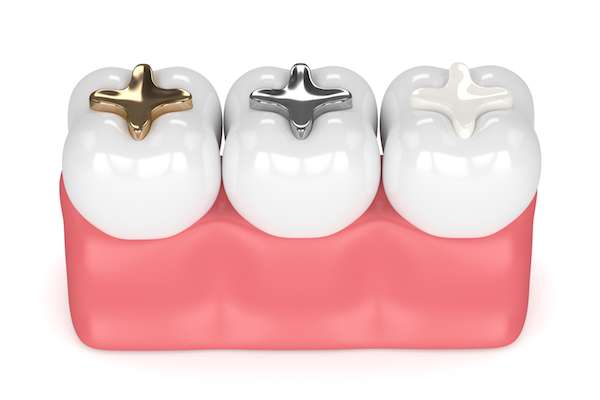 When a patient has a cavity, a general dentist thoroughly takes out all the decayed area of the tooth and replaces it with a filling in the empty space to prevent future decay. When it comes to the type of filling, there are various options from which the patient may choose. They each have advantages and disadvantages, and one may be the better choice based on the severity and location of decay, the patient’s budget, and aesthetic goals.
When a patient has a cavity, a general dentist thoroughly takes out all the decayed area of the tooth and replaces it with a filling in the empty space to prevent future decay. When it comes to the type of filling, there are various options from which the patient may choose. They each have advantages and disadvantages, and one may be the better choice based on the severity and location of decay, the patient’s budget, and aesthetic goals.
Types of dental fillings
A general dentist recommends getting a filling as soon as possible after the noted presence of a cavity. Leaving it untreated makes the problem worse and intensifies any pain or other symptoms. During the visit, the decayed area is removed, and the placement of a filling prevents the decay from becoming worse.
Composite resin
A resin filling is made from a mixture of plastic and minute glass particles. One advantage of this type of filling is that it is the color of the surrounding teeth, so it is virtually impossible to see. This makes a resin filling ideal for the front teeth. If this filling is placed on the tooth directly, it adds strength, which may prevent future damage.
One of the disadvantages of a composite resin filling is that it does not last very long, so it will probably need to be replaced at some point. The placement of the filling also takes longer than a silver filling although shorter than a gold one.
Silver
A silver filling is made up of small traces of silver, tin, copper, and mercury. It is a popular option with patients because it is the most affordable. It is also easier and quicker to place, as it fits nicely into the space where the cavity was removed.
In terms of durability, a silver filling typically lasts for 10 to 15 years, which is longer than resin fillings but shorter than gold. One disadvantage is that the silver color makes the filling obvious. For this reason, a silver filling is usually used on teeth located in the back of the mouth. Some patients are also concerned about the presence of mercury in the filling though dental professionals say it is not enough to be detrimental to one’s health.
Gold
Made of gold, this filling is also used mainly on the back teeth. A general dentist may recommend this option due to its most popular advantage, which is extreme durability. Due to the materials used, it should last a long time if a patient practices good oral hygiene.
One disadvantage of a gold filling is the cost. It is the most expensive option compared to the other two. Another disadvantage is the color since it may look like the affected tooth is discolored or very yellow. It also takes two visits to place this filling as it is created in a dental lab based on a mold of the patient’s tooth.
Conclusion
Getting a cavity filled is important to stop the decay and prevent future issues. A general dentist will help the patient decide which type of filling is a good choice for a specific situation and the patient’s goals.
Request an appointment or call Valley Harvest Dental Care at 707-690-6090 for an appointment in our Napa office.
Related Posts
A general dentist is the dental equivalent of a primary care physician. A general dental professional is the person dental patients can go to for routine preventative care and diagnosis of any oral health problems. There are multiple benefits to establishing a relationship with a general dentist.Maintaining oral health is important for both the health…
A general dentist may recommend a mouthguard to protect the teeth from damage that can occur from teeth grinding, sports injuries, or physically strenuous jobs. Grinding can be difficult to treat, but a patient can be helped by a thin mouthguard on the upper or lower teeth to prevent friction from occurring. Other types of…
Braces come with many benefits for patients, but one disadvantage that a general dentist may point out is staining. Stains are not an unavoidable result of having braces on for long periods of time. However, braces can make it harder to thoroughly clean teeth on a regular basis, which can eventually lead to stains. Here…
